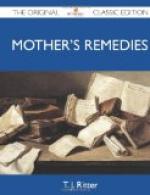A woman’s card should be of medium size and nearly square. Plain script, Old English or Roman are the only letterings used. Engraved plates, once obtained, may be used a long time. The street address, if used, is at the lower right-hand corner. This can be changed on one’s plate, if necessary, by ways known to the maker. Men’s cards are much smaller than women’s, and must be engraved. The name is always prefaced by “Mr.”
Use of Names.—A married woman uses her husband’s full name on her cards. A widow who happens to be the oldest representative of the family may have her cards engraved without her own or her husband’s name, as “Mrs. Astor;” this signifies her place as social head of the family. A clergyman’s card may have Rev. as a prefix; a physician’s Dr., never M. D. A young girl is always Miss, and pet names are without social recognition. For a year after she enters society a girl has her name engraved beneath her mother’s; where there are several daughters “out,” “The Misses Smith” may be engraved under the mother’s name. A widow may act her pleasure as to using her Christian name or her late husband’s on her card; the latter is customary. It would be a social convenience to use the Christian name, as with the prefix “Mrs.” widowhood would be indicated.
[690 Mothers’ remedies ]
The etiquette of calls.
As has been said, a woman is expected to call on her friends once a year at least. The “Day at Home” has rather gone out of fashion. It imposed an obligation on the hostess which often proved irksome, interfering with engagements she might wish to make. If, however, one has “a day,” her friends should so far as possible observe it.
Time and Manner.—The time limit of a call is fifteen or twenty minutes, not to exceed the latter. This is the protection society affords us from bores. We can endure even the most tiresome of visitors for fifteen minutes.
If one does not wish to see callers, the maid or whoever answers the door should be so informed; the conventional “Not at home” being perfectly proper; it is merely a polite way of saying it is not convenient to receive anyone. But for the maid to say “I will see, if Mrs. A is at home,” and return to say she is not at home or not receiving, is a grave discourtesy. Nor should one keep a visitor waiting while she makes an elaborate toilette; better say “Not at home.” The call counts as a visit whether the lady is at home or not, and must be returned. It is not customary to invite a visitor to be seated, to come again, or urge a longer stay. It is supposed she will take the initiative in these particulars; and too, that the fact that the two exchange visits warrants a certain wontedness of habit. Still, among intimates it is by no means unusual for the hostess to say “Do come again soon; I always enjoy you so much I should be glad to see more of you,” or for the departing visitor to say: “I shall hope to have the pleasure of seeing you at my home soon.”




